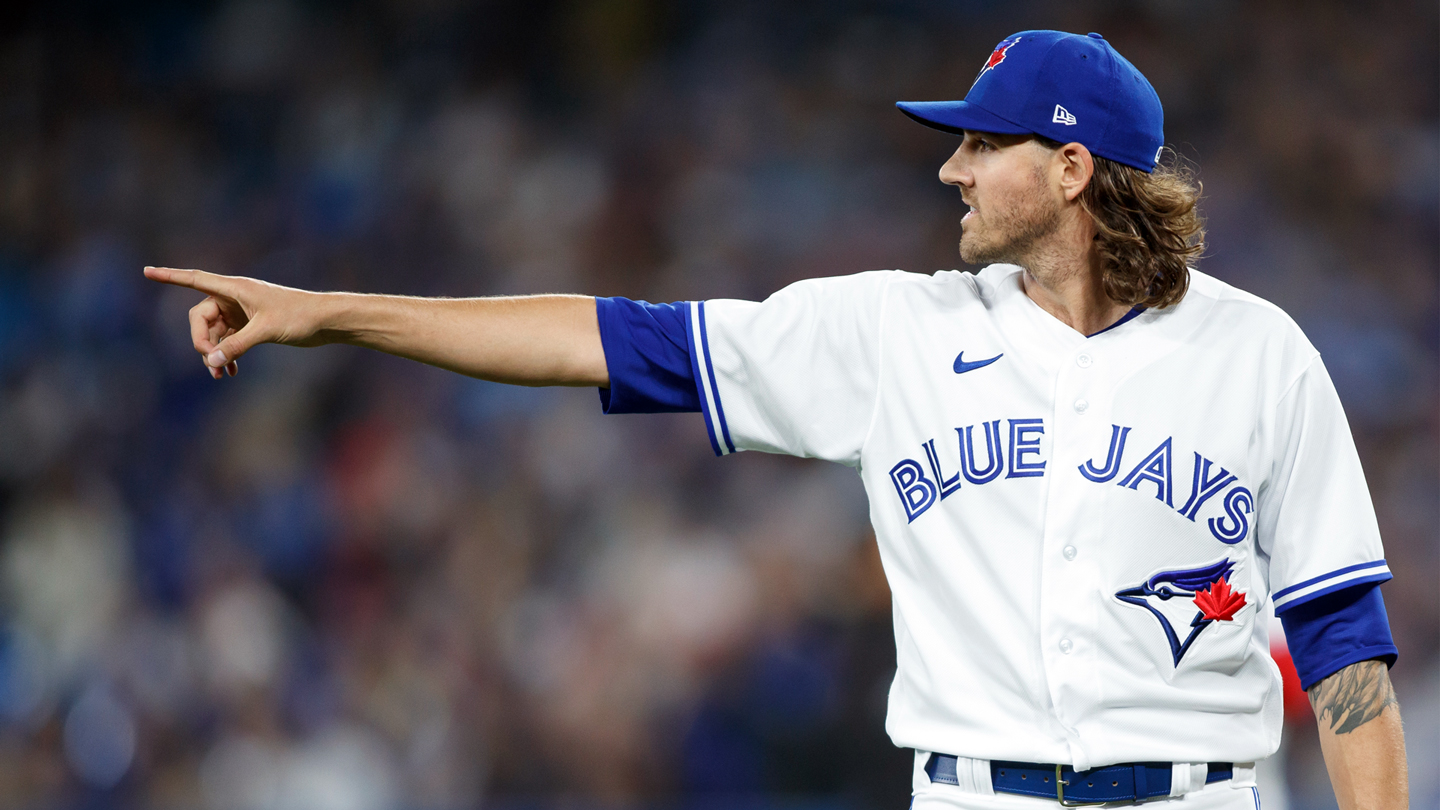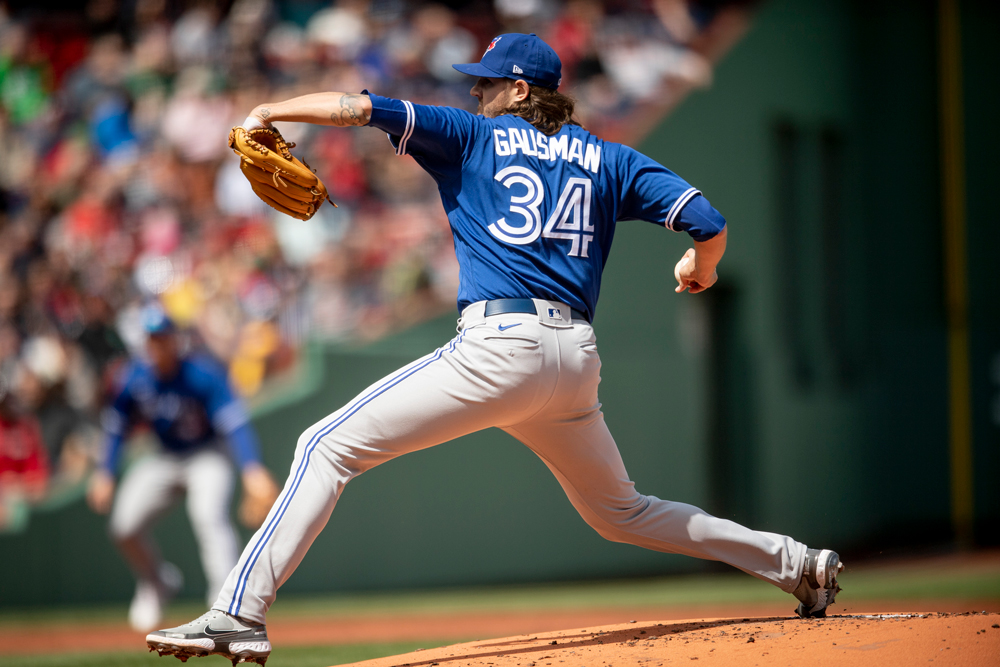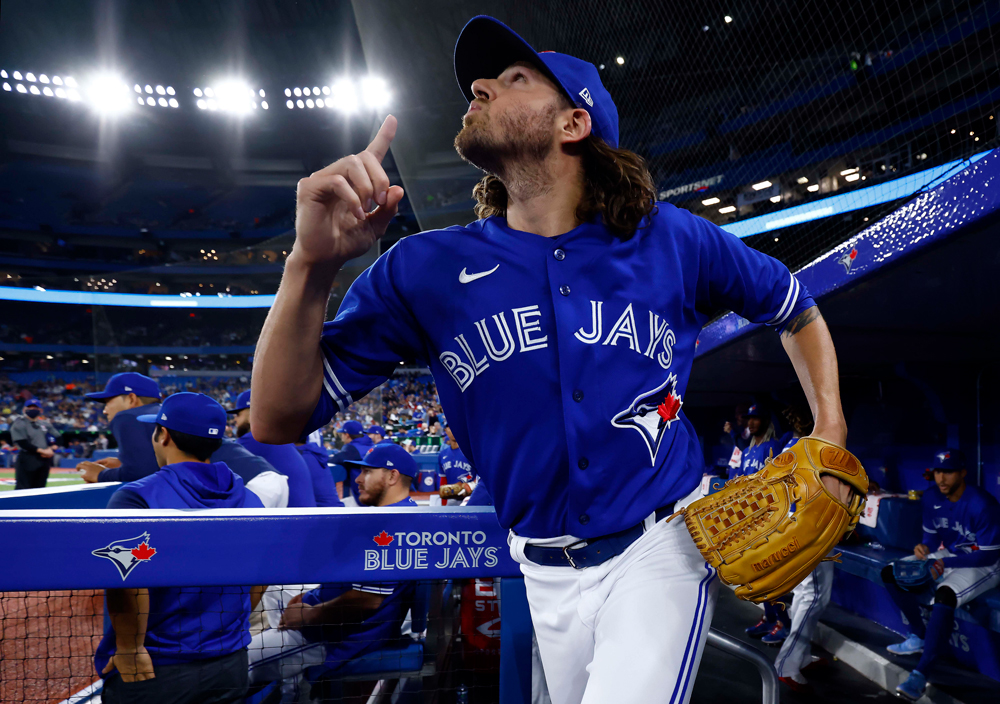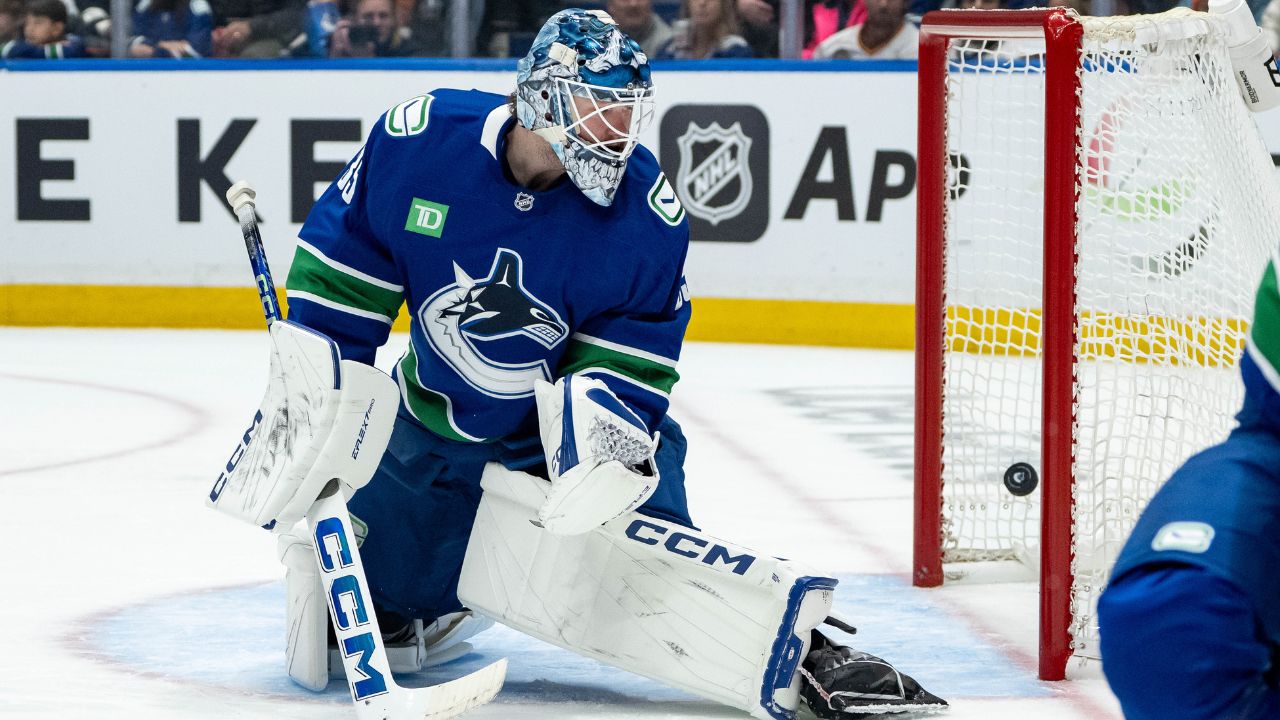
THE GENESIS

T
o this point, life on the mound has been a roller-coaster ride for Kevin Gausman. It’s August of 2019 and the sting of being designated for assignment by the Atlanta Braves just days ago is still fresh in his mind. He’s pitching out of the Cincinnati Reds’ bullpen now, and in addition to the shot his confidence just took, his new role is an unfamiliar one.
Gausman’s been a starting pitcher for the majority of his career, and at times, a very successful one. In 2018 he posted a 2.87 ERA across 10 starts with the Braves, after the club acquired him from Baltimore. But true to his amusement park ride of a big-league career, those good times didn’t last. And so here he is, at 28 years old, feeling almost like he’s starting from scratch.
How he arrived at this place is perplexing for Gausman. He knows he’s got the tools to succeed — most notably a devastating split-fingered fastball. The Reds respect that standout weapon in his arsenal and pitching coach Derek Johnson made sure to let Gausman know as much on his first day with the organization. He told the right-hander that he’d be a reliever for the rest of the campaign and his repertoire would be stripped down to only two pitches — a four-seam fastball, along with the splitter. “Fastballs up in the zone, splits down. Just grip and rip,” Johnson advised Gausman. “We think you can be a premium backend reliever with those two pitches.” Gausman had heard that line of thinking before, but this time he accepts it and then some. The approach works.
In his fourth outing with the club, against the St. Louis Cardinals, everything seems to click. He enters the game in the eighth inning and makes quick work of Paul DeJong, Yadier Molina and Lane Thomas, getting each hitter to strike out swinging. In the next frame, he bests himself. Gausman fires just nine pitches, all strikes, retiring three more batters on swings and misses. The rare “immaculate inning” causes Gausman to rethink his new place in the game. “In my head, I’m like, ‘To be honest, I don’t know if I’ll ever be a starter again because I’m doing so well at this,’” Gausman recalls of his thoughts at the time. “‘Maybe I’m just a nasty bullpen guy.’”
Fast forward to 2022 and there’s no “maybe” required: Gausman is definitely nasty, only now he’s back to plying his trade from the rotation. The 31-year-old is a starting pitcher again, and given the five-year, $110-million deal he signed with the Toronto Blue Jays this off-season, he’s cemented in that role. The “how” of it all is pretty simple: When he finally figured out how to maximize his greatest weapon — that otherworldly splitter — he was rewarded with the comfort of certainty in the majors. And yet, getting to this point was anything but an A-to-B journey. It took years of trial-and-error, of tinkering, for the pitch to become what it is today — measurably the best splitter in baseball, one of the best single pitches in the sport. “At first, I didn’t really know what it was going to be,” says Gausman. He, and the whole baseball world, certainly know now.
This is the story of that pitch, how the right-hander eventually mastered it and what it became.

T
he origin of Gausman’s splitter lies back in 1993 with a man named Chris Baum. A six-foot-three right-hander with the University of New Mexico, Baum had just finished his sophomore year and was pitching in an Arizona summer collegiate league. His team was working out one day at the Grand Canyon University ballpark in Phoenix when Baum became mesmerized by a stranger on the mound who was darting a pitch that seemed to disappear — it was as if the top half of the ball was sliced off midway to the plate, causing the rest to plummet viciously. Baum had been searching for a second off-speed pitch to complement his hard, heavy fastball and 12-6 curve. He’d tried a changeup, forkball and even a palm ball, but nothing seemed to work.
Always one to actively seek out information, Baum approached the stranger and sparked a conversation. In the 10 minutes they spoke, he discovered the pitcher was from the Houston Astros organization and was only at the ballpark to squeeze in a quick bullpen session before heading out of town. The right-hander showed Baum the grip of his pitch — his middle finger touching the outside of one seam and his index finger well to the left of the other, curled over his thumb on the side of the ball, almost like a circle changeup. “You have to play with this to figure out how it’s going to work for you,” he told Baum, noting that widening or narrowing the space between his fingers would impact its movement in different ways and alter speeds. He then handed the ball to Baum to try out the grip.
“It was instantly amazing for me,” recalls Baum. “I didn’t have to do anything to control my wrist and the harder I tried to throw it, the better it was. It was crazy how the way you are supposed to throw it just meshed with what my body wanted to do.”
Baum forgot to ask the pitcher’s name. To this day, he doesn’t know who he was. Yet, the gift he received changed his life. Baum played with the pitch and sharpened it before taking it back to college in the fall. He began to sling it during intrasquads and at one point, the best hitter on the team, Antonio Fernandez, was so baffled by the splitter that he swung through it and lost grip of his bat, launching it over the dugout and into the parking lot. “At that point, I was like, ‘Oh, this is pretty special,’” says Baum.
Splitters hit the peak of their MLB popularity in the 1980s and early ’90s, with several star pitchers such as Bruce Sutter, Jack Morris, Roger Clemens and David Cone riding the pitch to success. However, over time, a stigma developed around the grip. It was thought that the action of splitting the index and middle fingers wide put extreme pressure on the forearm and elbow, increasing the chance of injury. Some organizations even dissuaded pitchers from throwing it. Dave Stewart, who collected three World Series rings with the help of his forkball — a sister pitch of the split-finger fastball — remembers hearing concerns about the splitter in the ’80s. “[The injury concern] was around in my playing period,” Stewart says. “It started around the time of Roger Craig, who was considered to be the guru of teaching the split-finger fastball and forkball, and just gained steam.”
Blue Jays pitching coach Pete Walker threw a splitter during his major-league career and though he never experienced elbow issues, he recalls the concern. “There was speculation at the time that maybe it was a pitch that led to more injuries in the game,” says Walker. “But I don’t think science has proved that. I haven’t seen many studies on that and there’s guys that still throw the splitter who haven’t had any issues at all.” But even if the worry about its use is unwarranted, numbers show the pitch is still underutilized: Only 29 hurlers tossed more than 100 splitters last season, according to Baseball Savant — a list that includes stars Shohei Ohtani, Aroldis Chapman and Yu Darvish, among others.
Gausman already possessed immense talent when the splitter entered his life. When he was a tall, lanky kid in his early days at Grandview High School in Aurora, Colo., the right-hander built a reputation with his power. “He just threw really hard,” says Greg Bird, who caught Gausman in high school and later became a major-leaguer in his own right. “That was when high, high velo was just becoming a big deal. In high school in Colorado, if you had a guy throwing ninety something, that was crazy. I remember when he hit 97 or 98 [mph]or something for the first time and everyone was like, ‘What the F is going on?’”
Gausman could survive with just that fastball and his curve, but understood after his sophomore year that in order to thrive, he needed another off-speed pitch he could rely on. He tried to learn a changeup, but just couldn’t develop a feel for it, so he decided to consult with Baum, who was now the junior varsity coach at Grandview. The two already had a strong relationship — Baum had coached Gausman’s older brother, Brian, a few years prior — and Baum, of course, knew what it was like to search for that same addition to the repertoire.
“Try this, see how it works,” Baum told Gausman. “You’re going to have to play with it. Try it, fiddle around, and every time you do, try something a little bit different. And then when something good happens, remember it and build off of that because it just takes time. Once you figure it out, it does some pretty amazing stuff.”
The splitter was difficult for Gausman to harness. His initial efforts were wildly inconsistent — one throw would cut well, the next would sail over a right-handed batter. He kept working at it intermittently over the next two years of high school and eventually gained a bit of feel for the pitch. Throwing to his father, Clair, in their backyard, Gausman’s splitter would dive in the dirt so wickedly that, even wearing a shin guard and a chest protector, his dad would walk away with bruises. “He was like a teenager with the keys to a Ferrari and a lead foot,” says Baum. “He doesn’t really know where it’s going all the time, but he knows it’s going there fast.”
Gausman played in a California collegiate league the summer after graduation and continued to diligently fine-tune the “pitch with the Vulcan grip,” as Bird likes to call it. (Gausman calls his version a “fosh.” He doesn’t remember where the name comes from or even what it means, but he doesn’t consider his a traditional splitter because he utilizes more of the thumb.) He discovered that he could manipulate movement and speed depending on where he placed his thumb. When he first started using the pitch, his thumb was underneath the ball, but he eventually learned he could direct the ball inward to a right-handed batter by moving his thumb up. If he shifted his pointer finger down and tucked it around his thumb, he could throw a nasty splitter that wouldn’t even come close to the strike zone, but rather bottom out and entice a hopeless swing.
Gausman’s teammates at Louisiana State University named the offering “The Waterfall” and when he arrived at the school in 2011, he noticed that tossing it outside of Colorado — a state located in high altitude with low humidity, conditions that flatten breaking pitches — only made it better. LSU’s pitching coach, Alan Dunn, who had previously been the minor-league pitching coordinator for the Baltimore Orioles, saw Gausman throw the splitter in a bullpen session and told him it was “going to be a big pitch for you in the future.”
He pitched for the USA Baseball Collegiate National Team and during a game against Japan, Gausman received probably the biggest affirmation in his life to that point. “I remember before the game people were saying that a lot of the Japanese pitchers throw splits,” he says. “And to just know that going in, I have to be a little bit more fine with it. I ended up getting a ton of swings and misses that day on my splitter. And that was one of the moments where I was like, ‘Alright, these guys see this pitch a lot and I still was able to do that to them. If that’s the case, maybe [Dunn is] right, maybe I am on the right track with where I’m going with this pitch.’”

T
he endorsements continued for Gausman when he arrived in the majors after being drafted fourth overall by the Orioles in 2012. He debuted in the big leagues the following season and by 2014, was a key contributor in the rotation. The right-hander recalls striking out Texas Rangers slugger Josh Hamilton on a flithy splitter in the early days of his career: “At that point, that was probably the best split that I had thrown in the big leagues. That was the most I’ve seen that pitch move up to that point. He swung and missed and it was in the [other]batter’s box.”
Gausman watched video of the pitch the next day and tried to discern what he’d done differently. He couldn’t figure it out, though. His split could be monstrous, but it could also be terribly inconsistent. Orioles catchers knew that and weren’t inclined to call for it, especially in big situations. Gausman admits he had a hard time shaking off Matt Wieters, Baltimore’s all-star backstop, and that led to relying more on other pitches, which produced mixed results and, later, regret. “So many times I’d be lying in bed with my wife and be like, ‘I knew I shouldn’t have thrown that pitch. Why did I throw that pitch?’” he says. “I was constantly the guy that was up at night rethinking every pitch that I threw. Having success, but also just kind of grinding.”
The right-hander posted an ERA-plus of 101 across his first five years in the majors, a number that places him almost exactly at the league average. He was a serviceable starter, for sure, but wasn’t exactly fulfilling his potential as a top-five pick. The Orioles traded him to Atlanta in the middle of the 2018 season and the change exposed him to a different way of thinking. Atlanta got him to pitch primarily out of the stretch and alerted him to the fact that fastballs down in the zone were accounting for much of his struggles. Gausman needed to elevate that pitch and pair it with splitters down, they suggested. He tried that North-South formula and found instant success, putting together an impressive string of outings. He noticed that hitters were whiffing on fastballs up in the zone; pitches he never thought they would even bite on.
Gausman hurt his shoulder that off-season and wasn’t the same pitcher at the beginning of 2019. “I was trying to do the same thing I did the year before, but I just couldn’t get my fastball up,” he says. “I’m getting guys 0-2, 1-2, trying to put them away with the fastball up and missing middle-middle or belt-high, and they’re just doing damage.” He completely unravelled during a six-start span that saw him allow 47 hits and 29 earned runs over 26 innings, leading the Braves to DFA him. It seemed like he was back to square one, having undone all the success and discovery from the previous season.
Taken off waivers by the Reds, he had no choice but to embrace the club’s belief in his potential out of the bullpen. Gausman listened to pitching coach Derek Johnson’s words and doubled down on the fastballs-up-splitters-down approach. He regained a few ticks on his fastball, completely ditched his changeup, and tossed more of his signature pitch than ever before. Gausman threw his splitter 37.7 per cent of the time in 2019, up from 24 per cent the previous year.
When he hit free agency that winter, Gausman received several offers, but the San Francisco Giants were one of the few teams to present him with an opportunity to return to the rotation. “‘We want you to be a starter, but we want you to pitch just how you pitched with the Reds out of the bullpen,’” Gausman recalls the Giants saying. “So, I was like, ‘You want me to be essentially a two-pitch starter?’ They said, ‘Yes, we believe that your two pitches are good enough to where you can do it.’”
Gausman excelled in San Francisco during the COVID-shortened 2020 season, then constructed a masterpiece in 2021, fully realizing his immense potential. The Giants wanted him to throw even more fastballs up in the zone and showed him video of how fellow starters Trevor Bauer and Blake Snell benefitted from that approach. Gausman’s fastball and splitter are symbiotic in a sense, as they both use the same arm slot and release point, leaving the hitter with barely any time to decipher which one he’s seeing. “I’m going to have more leeway on my split if I’m throwing fastballs up in the zone,” says Gausman. “There’s more room for error because I’ve established up. Hitters are going to see it up and they might even give up on it because they think it’s too high or they’re going to get big-eyed and try to do damage and the separation of speed and metrics is going to be able to help me out.”
Gausman threw 1,061 splits last season (35.3 per cent of his pitches), a whopping 383 more than Frankie Montas, who utilized the pitch second-most. Opponents hit just .133 off it and swung and missed 45.9 per cent of the time. According to Statcast’s Run Value score, only Carlos Rodon’s four-seam fastball was a better pitch in 2021.
Gausman hurled his fastball 52.7 per cent of the time and with the deadly combination working, he produced easily the best campaign of his career, posting a 2.81 ERA over 33 starts and a career-high 192 innings. His 5.1 wins above replacement and 227 strikeouts were also career bests. Gausman has maintained that dominance through the first month of this campaign with the Blue Jays, compiling a 2.19 ERA over his first four starts. He’s also struck out 31 batters over 24.2 innings without issuing a walk or surrendering a home run. The splitter has arrived in Toronto with a vengeance, producing a 51.8 per cent whiff rate in the early going.
Landing in this spot required Gausman to learn the nuances of his unique weapon, picking up tidbits of information along the way and applying them in exactly the right combination — how to throw it, when to throw it, where to throw it. He needed to live the words that stranger from the Astros told Baum many years ago, the ones Baum eventually relayed to him: He had to “play with it.”
“I didn’t understand that the more I threw it, the better it was going to get,” he says. “That’s the biggest difference between the last few years. I just think it’s like the more you do anything — the more you write, the better writer you’re going to be; the more you run, the longer you’re going to be able to run. I just got a better feel for it.”
Gausman made sure to shout out Baum, who still works at Grandview, at his introductory Zoom press conference with the Blue Jays, giving him credit for teaching him the pitch. Looking back now, Gausman has an idea of where his life would be without it. “I don’t know if I would have even got to the big leagues,” he says. “I think I would have gone to college. I probably would have been a closer in college, just throwing fastballs.”
Baum saw video of the presser and felt immense pride at the mention. He jokes that if he could have thrown 95 mph, he might be getting the $110-million cheque, but instead, he’s just grateful to have had the chance to play an impactful role in his former pupil’s journey.
“I’m happy that it worked for him as well as it worked for me,” says Baum. “I’m just excited that he’s still getting to play and I managed to not screw him up.”
Cole Burston/Getty Images; Maddie Malhotra/Boston Red Sox/Getty Images; Vaughn Ridley/Getty Images.




